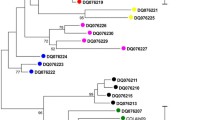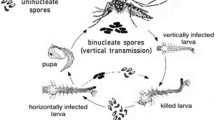Abstract
Inbred stocks of the tree-hole mosquitoAedes triseriatus from four localities were developed using full-sib mating. The progress of inbreeding was followed electrophoretically at eight variable and six less variable enzyme loci. Rates of fixation of several of these loci were substantially lower than expected. Discrepancies between observed and expected fixation values were evident in the early stages of inbreeding and became larger as inbreeding progressed.Odh, Hbd, Pgm, andHk-4 were usually not fixed. By the F12 and F14 generations of brother-sister mating, most individuals in the two lines were heterozygotes (Odh andHbd in the TK lines andOdh, Hbd, Pgm, andHk-4 in the TV lines). The probability of maintaining heterozygosity at several selectively neutral and unlinked loci simultaneously is very low.Odh, Hbd, Pgm, andHbd loci are linked to lethal recessives on chromosome 2, creating a balanced lethal system which in turn accounts for the heterozygosity in these inbred mosquitoes.
Similar content being viewed by others
References
Abplanalp, H., Hagger, C., and Briles, R. (1981). Genetic variation of blood groups in inbred lines of Leghorns, derived from a common base population.J. Hered. 72224.
Craig, G. B., Jr. (1964). Applications of genetic technology to mosquito rearing.Bull. WHO 31469.
Crow, J. F., and Kimura, M. (1970).An Introduction to Population Genetics Theory Harper and Row, New York.
Erickson, K., Halkka, O., Lokka, J., and Saura, A. (1976). Enzyme polymorphisms in feral, outbred, and inbred rats (Rattus norvegicus).Heredity 37341.
Falconer, D. S. (1961).Introduction to Quantitative Genetics Ronald Press, New York.
Festing, M. F. W. (1979).Inbred Strains in Biomedical Research Oxford University Press, New York.
Gowen, J. W. (1952). Hybrid vigor inDrosophila. In Gowen, J. W. (ed.),Heterosis, Iowa State College Press, Ames, pp. 474–493.
Hayman, B. I., and Mather, K. (1953). The progress of inbreeding when homozygotes are at a disadvantage.Heredity 7165.
Johnson, F. M., Richardson, R. H., and Kambysellis, M. P. (1968). Isozyme variability in species of the genusDrosophila. III. Qualitative comparison of the esterases ofD. aldrichi andD. mulleri.Biochem. Genet. 1239.
Kempthorne, O. (1957).An Introduction to Genetic Statistics John Wiley and Sons, New York.
Matthews, T. C., and Craig, G. B., Jr. (1980). Genetic heterozygosity in natural populations of the tree-hole mosquitoAedes triseriatus.Ann. Entomol. Soc. Am. 73739.
Michie, D., and Anderson, N. F. (1966). A strong selective effect associated with a histocompatibility gene in the rat.Ann. N.Y. Acad. Sci. 12988.
Munstermann, L. E. (1985). Geographic patterns of genetic variation in the treehole mosquitoAedes triseriatus. In Lounibos, L. P., Rey, J. R., and Frank, J. H. (eds.),Ecology of Mosquitoes Florida Medical Entomology Laboratory, Vero Beach, pp. 327–343.
Munstermann, L. E., Taylor, D. B., and Matthews, T. C. (1982). Population genetics and speciation in theAedes triseriatus group. In Steiner, W. W. M., Tabachnick, W. J., Rai, K. S., and Narang, S. (eds.),Recent Developments in the Genetics of Insect Disease Vectors Stipes, Champaign, Ill. pp. 433–453.
Reeve, E. C. R. (1955). Inbreeding with homozygotes at a disadvantage.Ann. Human Genet. (Lond.)19332.
Singh, H., and Nordskog, A. W. (1981). Biochemical polymorphic systems in inbred lines of chickens: A survey.Biochem. Genet. 191031.
Wallace, B., and Madden, C. (1965). Studies on inbred strains ofDrosophila melanogaster.Am. Nat. 99495.
Wallace, M. E. (1965). The relative homozygosity of inbred lines and closed colonies.J. Theor. Biol. 993.
Wills, C., and Nichols, L. (1971). Single gene heterosis inDrosophila revealed by inbreeding.Nature 233123.
Author information
Authors and Affiliations
Additional information
This project was supported by National Institutes of Health Grant Al-02753 to G.B.C.
Rights and permissions
About this article
Cite this article
Matthews, T.C., Craig, G.B. Heterozygosity in inbred strains of the tree-hole mosquitoAedes triseriatus . Biochem Genet 25, 647–655 (1987). https://doi.org/10.1007/BF00556209
Received:
Revised:
Issue Date:
DOI: https://doi.org/10.1007/BF00556209




